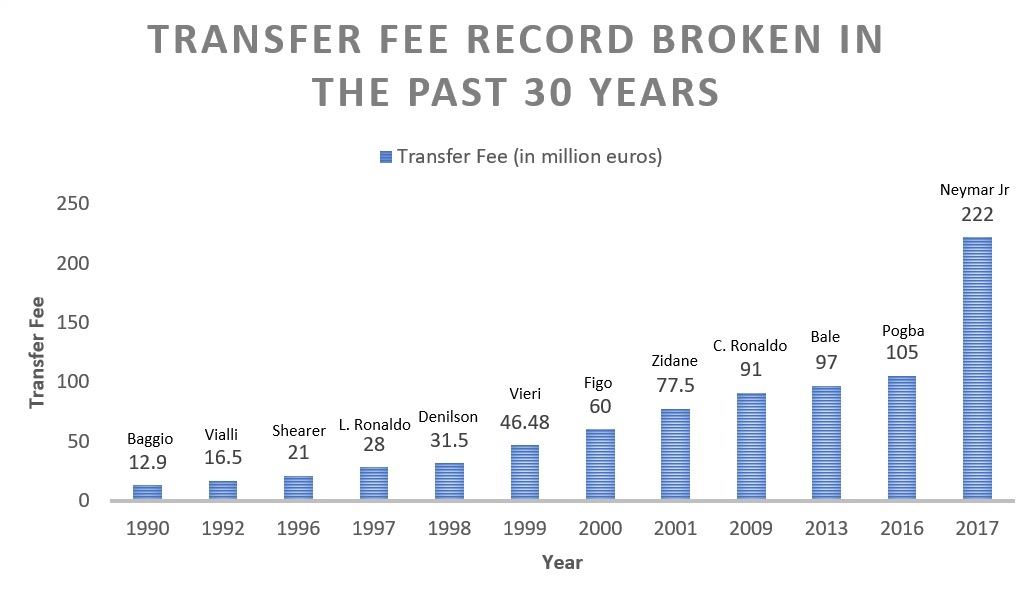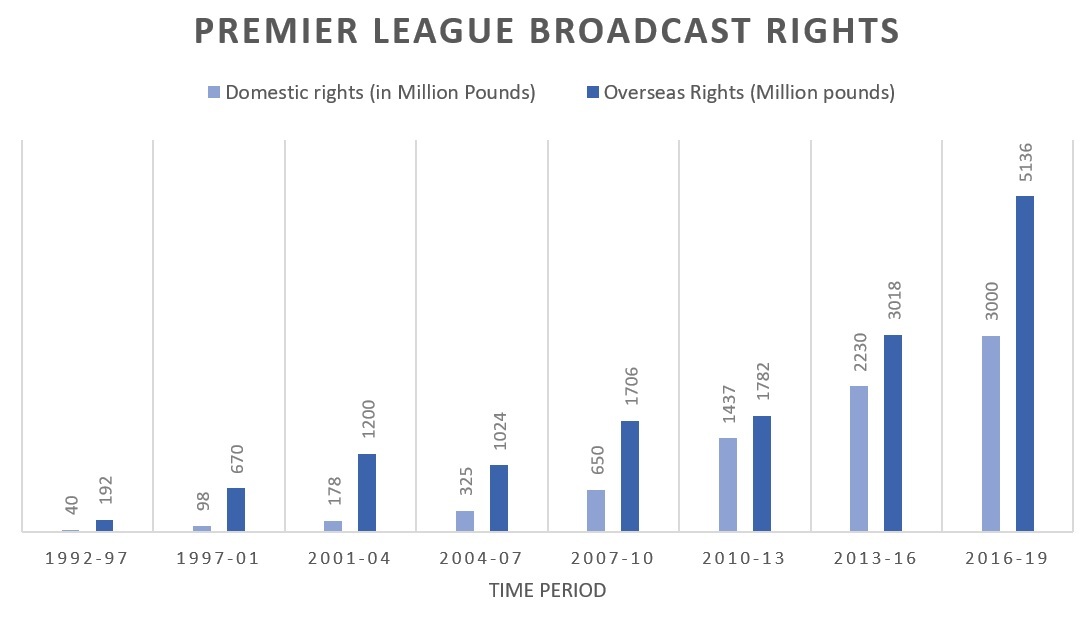Paris-Saint Germain sent shockwaves across Europe and other top football leagues in 2017 when they decided to activate the staggering €222 million release clause present in Neymar Jr’s contract at FC Barcelona. The Brazilian forward gave the green light to this transfer and decided to move to Paris from Catalonia. It has been a long journey completed in a short time by football to reach a stage when a club was paying more than €200 million for the services of a player.
Football transfers such as the one that involved high-profile and richly talented superstars such as Neymar Jr. have always been expensive. A top football club can be just a good footballer away from winning silverware, so ambitious clubs across the globe invest heavily in top players to meet their sporting motives.
Having said that, football transfer fees have always been ahead of global inflation and increased at a faster rate in the past three decades. The transfers are conducted during two transfer windows provided by FIFA; a winter window in January and a summer window that lasts for two months from July 1 to August 31.
According to a study from the International for Sports Studies (CIES) in Switzerland, a player will cost three times than what he did in 2011. The findings from the same study stated that there had been a mindboggling 26% yearly inflation growth rate for players traded in Europe’s top five football leagues, which includes top division competitions in Spain, England, France, Germany, and Italy.

In the space of one year, the world record transfer fee was more than doubled when Neymar. Jr joined Paris-Saint Germain. The consequences of Neymar’s transfer were felt as Barcelona went on to spend an initial €110 million and €120 million on Ousmane Dembele and Philippe Coutinho, respectively. There was a premium added to every transfer after 2017 as a consequence of the domino effect caused by Neymar’s transfer.
Factors deciding the overall transfer fee
Apart from the talent of the player, many underlying factors decide the transfer value of a player. A younger player with high potential is going to cost more than an established 30-year-old player. Moreover, image rights and the brand value of a player also contribute to the overall transfer fee.
There is a growing influence of player agents in football; high agent commissions in a transaction increase the final fee. Paul Pogba’s record transfer to Manchester United from Juventus was worth €105 million. According to Guardian, Pogba’s agent- Mino Raiola, ended up pocketing €26 million from the final fee for brokering the transfer. The length of a player’s existing contract and his importance to the selling club also decide the final transfer fee.
Growth of Broadcast Rights aiding inflation in transfer fee

In the above case, the Premier League is considered as an observation, but all other leagues in Europe have observed an upward trajectory in the broadcast rights over the last 30 years. Higher broadcasting rights led to increasing the TV revenue of individual clubs, allowing them to invest heavily to achieve success on the pitch. The massive growth observed in rights from 2007 till 2019 has coincided with big clubs not hesitating in breaching the €100 million mark for trading players.
Investment from rich businessmen in club
Data visualisation
Chelsea, Manchester City, and Paris- Saint Germain have tasted a lot of success in the 21st century after being in the shadow of other top clubs in the last century. Roman Abramovich, an oil oligarch in Russia, completed the Chelsea takeover in 2004. The Royal family of Abu Dhabi bought Manchester City in 2008 while Qatar Sports Investment completed the takeover of Paris Saint-Germain in 2011.
All three owners took up an aggressive approach to achieve success on the pitch, buying star players at exorbitant fees. The clip shows the spike in spending of all three clubs in a short space of time since the completion of their respective takeovers.
Eventually, spending a big amount of money in a small period takes a toll on the transfer market, leading to the inflation of transfer fees of players that struggle to justify the price tag. Barcelona and Real Madrid have traditionally been the biggest spenders due to the big sponsorship deals and worldwide traction they enjoy.
COVID19 is likely to halt the inflation of transfer fees
The 2019/20 season came to a halt across the globe due to the coronavirus pandemic. Most of the European countries went through a three-month lockdown period to decrease the rate of spread of the virus.
The majority of the European leagues were eventually concluded by the end of August, including the Champions League and Europa. Clubs have been recording losses in the final quarter of the season due to a lack of matchday revenue.
In an interview New York Times, Christian Siefert- Bundesliga’s Chief Executive, had predicted that the transfer market in summer will collapse due to the current situation. With 13 days to go, we are yet to see a transfer that commanded a nine-figure fee, which had become a norm for a couple of players in the previous windows.
Uli Hoeness, former Bayern Munich president, also expects the impact of the pandemic on transfers for a long time. While talking to Kicker (via ESPN), Hoeness admitted that pandemic may stop the inflation of transfer fees.
“The transfer fees will drop and will not return to the current level in the next two, three years. All countries are affected. There will most likely be a new footballing world. The current situation is a threat, but also a chance to change the coordinates. You can’t dictate it, but transfer fees in excess of €100 million will be a thing of the past for the next few years.”
Hoeness has always been critical about transfer fees, but his statement holds weight in this case as broadcast rights are going to take a massive hit due to the ongoing coronavirus pandemic.
According to The Athletic, Premier League was expected to lose £762 million if the ongoing campaign is not completed. However, the campaign was eventually concluded, so clubs had to pay the rebate for late telecast of games to broadcasters.
Clubs with bigger revenues are likely to withstand the pandemic, but clubs at the grassroots level could fold due to the lack of matchday revenue. Decrease in revenue is going to impact the transfer fees paid for players on both medium to long-term basis.
Meanwhile, the French league could find itself in a financial crisis due to lockdown. As per Business Standard, broadcasters of the French league have upheld payments to the league due to the indefinite suspension of the season.
The Guardian reports that Premier League has already received a request from DAZN, a streaming platform in Germany, to postpone payments for broadcast rights since there is no football being played at the moment.
Since broadcast revenues are set to drop off, many clubs will have less transfer kitty to spend in summer, and inflated transfer fee demands are unlikely to be satisfied. This could eventually burst the bubble in which football has been staying for the past decade.

